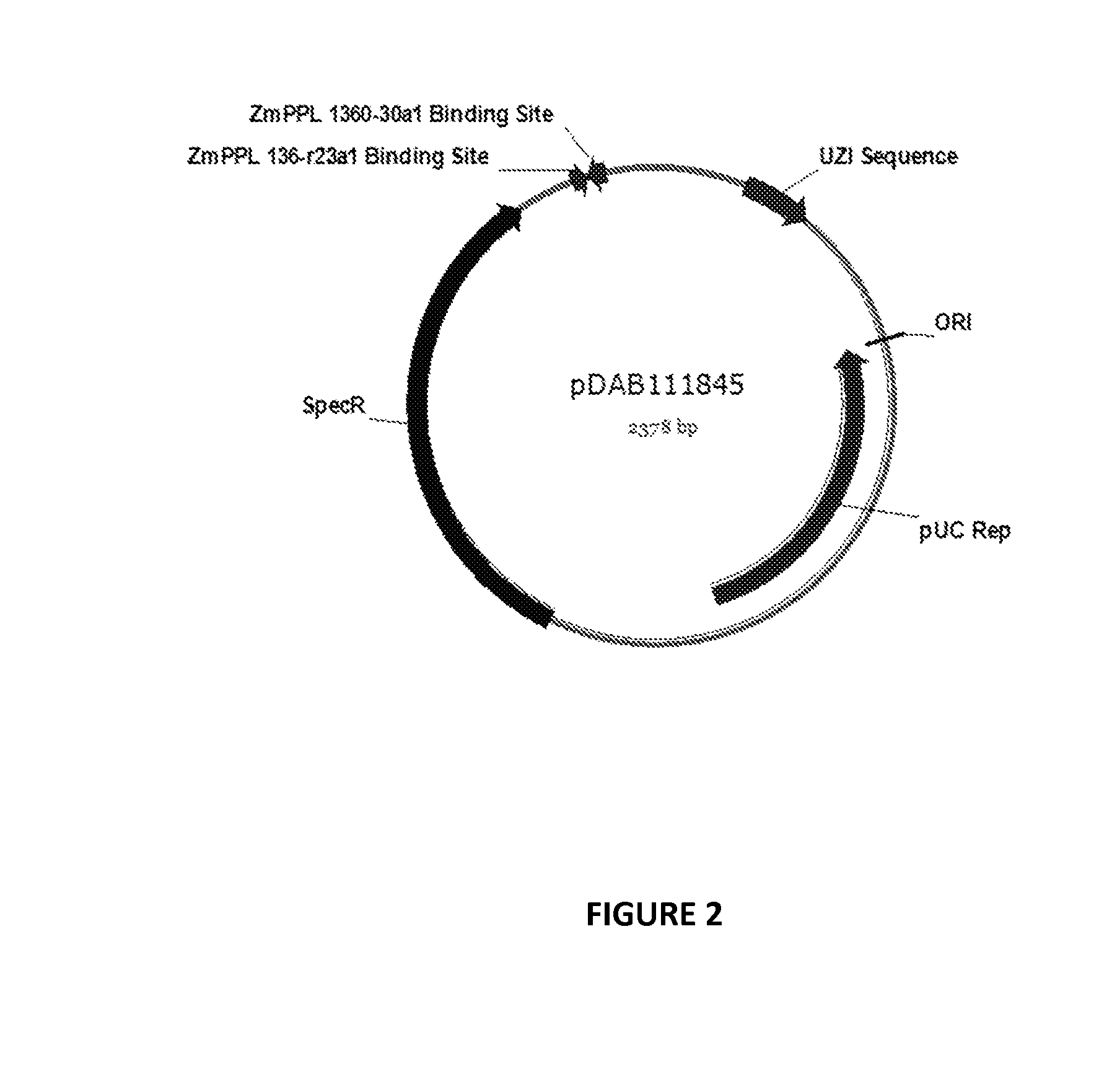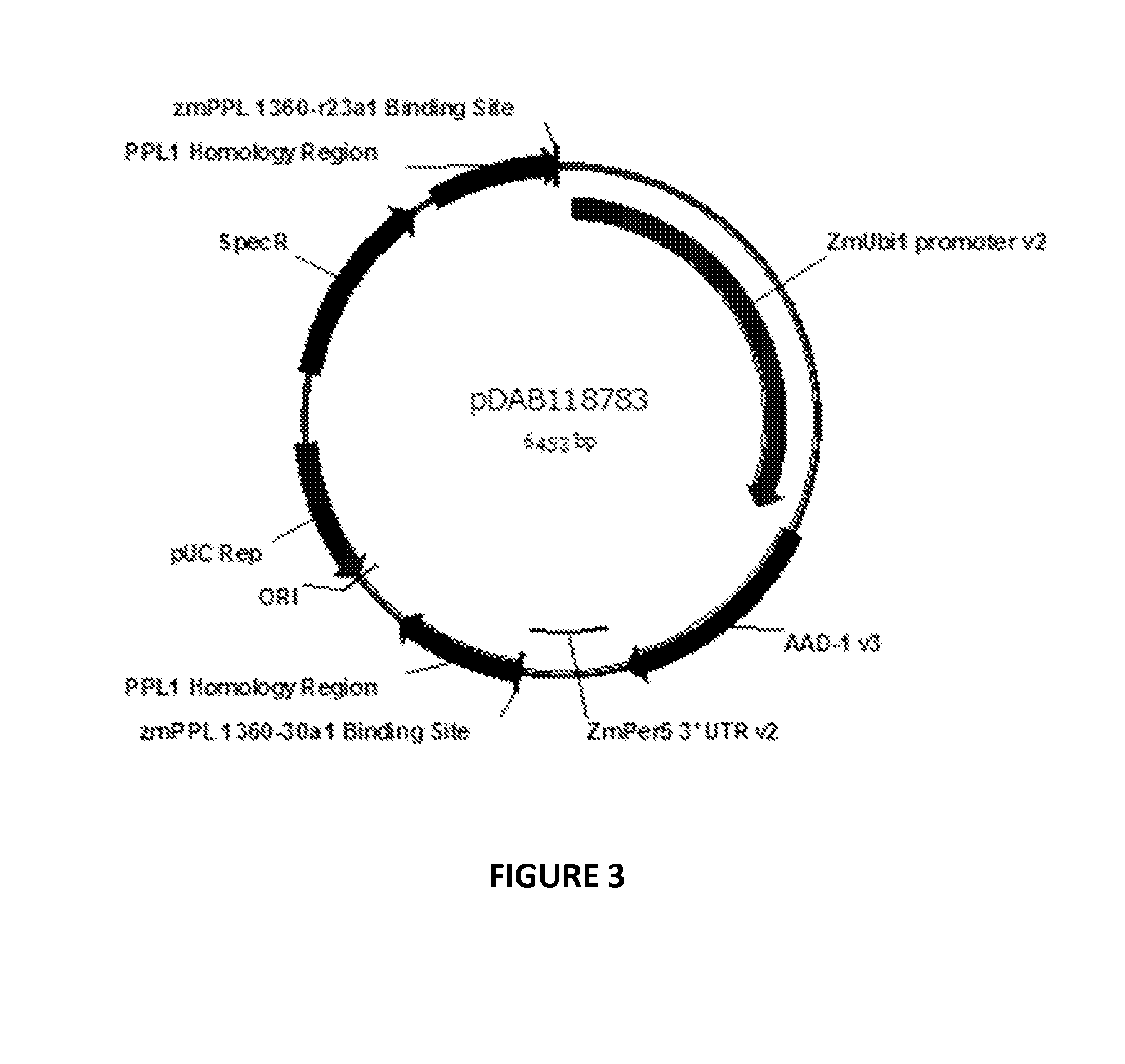Haploid maize transformation
a technology of haploid maize and transformation, which is applied in the field of haploid maize transformation, can solve the problems of reducing the efficiency of targeted transgene integration, and unable to achieve site-specific (targeted) modification of selected locations in the haploid genome of maize, and achieves stable genomic modification and stably integrated into the haploid genom
- Summary
- Abstract
- Description
- Claims
- Application Information
AI Technical Summary
Benefits of technology
Problems solved by technology
Method used
Image
Examples
example 1
Generation of Microspore-Derived Haploid Callus
[0256]Pre-emergent tassels of the Zea mays genotype 139 / 39-05 (U.S. Pat. No. 5,306,864) were harvested from greenhouse-grown maize plants (-5-6 week-old) when the microspores were at the early binucleate stage of development (anthers ˜3 mm long, bright, glossy yellow). The tassels were wrapped in moist paper towels and aluminum foil and placed into an incubator set at 8° C. for 7-14 days. Following surface sterilization (15 min in 0.08% v / v Chlorox™ followed by a sterile water rinse), anthers were aseptically isolated, placed onto the surface of liquid ‘anther culture medium’ (N6 salts and vitamins, 60 g / L sucrose, 5 g / L activated charcoal, 500 mg / L casein hydrolysate, 0.1 mg / L TIBA adjusted to pH 5.8) in 6-well dishes at a density of 60 anthers in 6 mL medium per well and incubated at 28° C. in the dark. Microspore-derived embryo-like structures, appearing between 14-28 days, were transferred to ‘callus medium’ (MS salts and vitamins, ...
example 2
Ploidy Determination of Callus
[0258]In order to determine cell ploidy level, 1 g of callus tissue made in Example 1 was transferred to a sterile PetriTM dish (Fisher Scientific, St. Louis, Mo.). Nuclei were released by chopping the callus tissue with a single-edged razor blade in the presence of 1-2 mL of filtered, ice cold Gailbraith buffer (0.01M MgSO4, 0.005M KCl, 0.0005M HEPES, 1 mg / mL DTT) along with ‘MMG medium’ (4 mM MES [pH 6.0], 0.6M mannitol, 15 mM MgCl2) and 0.25% Triton X-100™. The Petri™ dish was rinsed with an additional 2 mL of buffer, which was combined with the initial nuclear extract to make a final slurry volume of ˜5 mL. The crude nuclear extract was then gently homogenized by transferring to a glass tissue homogenizer and pumping the plunger up and down a couple of times. The homogenate was then filtered through tea strainers and the resultant filtrate was aspirated through a 40 μm Steri-flip™ (Millipore; Billerica, Mass., USA) to isolate nuclei. Isolated nuclei...
example 3
Constructs for Targeted Genome Modification in Protoplasts Isolated from Haploid Callus
[0259]For targeted genome modification, a zinc finger nuclease (ZFN) construct, pDAB111879 (depicted in FIG. 1), was used. Expression of the ZFN was driven by the maize ubil promoter and terminated with the maize per5 3′ UTR. This expression cassette contained the “T2A” architecture comprising two zinc finger monomeric domains (zmPPL—1360-r23a1 and zmPPL—1360-30a1) encoded by, and expressed from, a single coding region. The expressed transcript included the T2A stutter signal (Mattion et al., 1996, J. Virol., 70:8124-7) to introduce a ribosomal stutter that releases the first polypeptide during translation and is designed, upon further translation, to produce the first and second polypeptide in equimolar amounts. An opaque2 nuclear localization sequence (NLS) was included in both ZF monomers for targeting to the nucleus. Each of the two NLS-ZF domain fusions possesses binding specificity to the un...
PUM
| Property | Measurement | Unit |
|---|---|---|
| temperature | aaaaa | aaaaa |
| pH | aaaaa | aaaaa |
| density | aaaaa | aaaaa |
Abstract
Description
Claims
Application Information
 Login to View More
Login to View More - R&D
- Intellectual Property
- Life Sciences
- Materials
- Tech Scout
- Unparalleled Data Quality
- Higher Quality Content
- 60% Fewer Hallucinations
Browse by: Latest US Patents, China's latest patents, Technical Efficacy Thesaurus, Application Domain, Technology Topic, Popular Technical Reports.
© 2025 PatSnap. All rights reserved.Legal|Privacy policy|Modern Slavery Act Transparency Statement|Sitemap|About US| Contact US: help@patsnap.com



